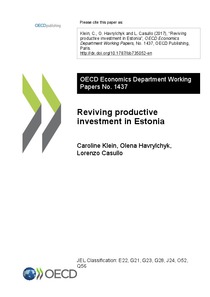Reviving productive investment in Estonia
"Since the crisis, Estonia has experienced one of the most pronounced declines in the ratio of non-residential investment to GDP in the OECD. In addition, investment in intangible capital has remained well below OECD standards, partly explaining the low innovative capacities of typical Estonian...
| Main Authors: | , , |
|---|---|
| Institution: | ETUI-European Trade Union Institute |
| Format: | TEXT |
| Language: | English |
| Published: |
Paris
2017
OECD |
| Subjects: | |
| Online Access: | https://www.labourline.org/KENTIKA-19396029124911142019-Reviving-productive-investment.htm |
| Summary: | "Since the crisis, Estonia has experienced one of the most pronounced declines in the ratio of non-residential investment to GDP in the OECD. In addition, investment in intangible capital has remained well below OECD standards, partly explaining the low innovative capacities of typical Estonian firms. Uncertainty created by regional geopolitical tensions has played a role but poor investment performance stems from domestic factors too, such as a normalisation after the boom years, the lack of adequate skills and insufficient incentives for risk-taking. Improving lifelong learning and maintaining skilled mothers in employment can contribute to reducing shortages in skills needed by investors. Restructuring of insolvent firms should be eased to increase credit recovery and redirect capital to the most productive ones. Developing alternatives to bank funding can support investment in small and innovative firms. While there is room to improve the quality of infrastructure further, selection and prioritisation of projects should improve. Incentives for green investment, in particular to reduce pollution emitted by the oil shale industry and to achieve energy efficiency gains, could be strengthened." |
|---|---|
| Physical Description: | 41 p. Digital |

